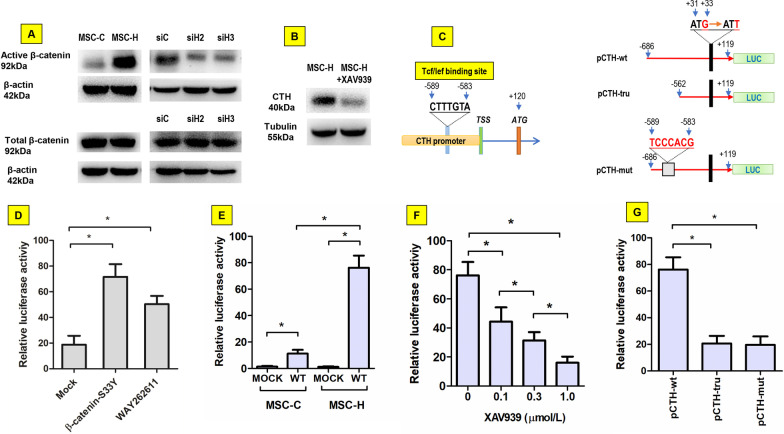Fig. 5.
Regulation of γ-cystathionase (CTH) transcriptional activity by Wnt/β-catenin signaling. The active isoform of β-catenin was increased in MSC-H cells although total β-catenin level was not changed. HMGB1 knock-down reduced active β-catenin without effect on total β-catenin expression as shown in siH2 and siH3 cells (a). Inhibition of Wnt/catenin signaling by 1.0 μmol/l XAV939 suppressed the CTH expression in MSC-H cells (b). A conserved TCF/LEF binding sequence 589 bp upstream of transcriptional start site was identified on CTH promoter by bioinformatics analysis. The wild-type CTH promoter was cloned into luciferase reporter plasmid (pCTH-wt). To validate the effect TCF/LEF binding element on promoter activity, the plasmids of pCTH-mut and pCTH-tru were constructed by introducing site-specific mutation and upstream truncation of the putative TCF/LEF binding site into CTH promoter, respectively (c). In dual luciferase assay, the relative luciferase activity of pCTH-wt was significantly increased by co-transfection of pCMV-S33Y-β-catenin into 293 T cells when compared to the mock plasmid. Moreover, stimulation of 293 T cells with 1.0 μmol/l WAY262611 also enhanced the luciferase activity of pCTH-wt (d). The luciferase activity of pCTH-wt was significantly higher in MSC-H cells than MSC-C cells (e). XAV939 reduced the luciferase activity of pCTH-wt in MSC-H cells in a dose-dependent manner (f). The pCTH-wt plasmid had significantly higher luciferase activity in MSC-H cells than pCTH-mut and pCTH-tru (g). The asterisk indicated a P value < 0.05

